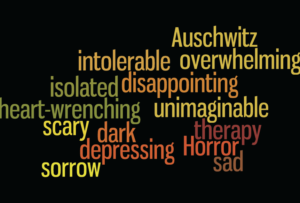 What drew me to this SoTL journey is a deep care for the emotional well-being of my students in their study of genocide. When I began my work as a Scholar, I began with something very concrete in my discipline. I teach a difficult subject matter, Holocaust Studies, and I wanted to learn more about the impact of my teaching approach on my students, for example how the language and visuals that I use affect student emotions.
What drew me to this SoTL journey is a deep care for the emotional well-being of my students in their study of genocide. When I began my work as a Scholar, I began with something very concrete in my discipline. I teach a difficult subject matter, Holocaust Studies, and I wanted to learn more about the impact of my teaching approach on my students, for example how the language and visuals that I use affect student emotions.
I assumed that this would be a closed project, with a fixed beginning and ending, in which I would discover specific findings. I now recognize that, as a scholar of my teaching and my students’ learning, I am a work-in-progress. My study focus has extended beyond specific tools for pedagogy, such as words and images, to focus on the classroom environment and what kind of community I’m trying to create with my students.
“The emotional journey is as important as conveying the facts of what happened.”
I’ve become increasingly aware of the “messiness” in how we are affected emotionally by the difficult subject matter of genocide. Many dimensions are intertwined: what I bring to the classroom with my own experience, and how that affects my students; what my students bring to the classroom and my efforts to respect how they respond to the course experience; and the steps we take together to create a learning environment in which students can experience strong emotions in a way that is productive to their growth. The CATLR SoTL community has helped me navigate this messiness and find ways to integrate emotions as an essential part of a learning space where virtues, ethics, and relationships are honored, and where our responsibility to prevent genocide is salient. I am not just looking for an emotional response from students; I am concerned with the extent to which the emotions help them cultivate a capacity for compassion and ethical thinking.
As a scholar of genocide studies, I recognize that the emotional journey is as important as conveying the facts of what happened. It’s important for the emotions (whatever they are) to be productive, to serve as a means for connecting to the suffering of others, so that students can apply what they have learned in future contexts.
Throughout the semester they experience horror, sadness, shock, and then somehow ideally derive something they want to take with them, to inform how they move through life as ethical and compassionate citizens and leaders, and to potentially engage in political action.
A key moment in my Scholars journey was when I identified a framework for an ethics of care that has allowed me to capture this triad of emotions, ethics, and content of genocide studies (Noddings, 2013). This framework gives me a vocabulary, literature, and pathways for helping my students develop a relationship with this challenging topic. In my syllabus, I now include a narrative on my course philosophy, and in the stated learning objectives and assessments, I invite students to reflect on and recognize their personal role and duty in the study of genocide.

The literature on contemplative pedagogy has also influenced my teaching (Barbezat & Bush, 2014). For example, I allow a few minutes of silence or read a passage of poetry before beginning a presentation, include mindful listening exercises, pause periodically for moments of contemplation during difficult conversations, and include opportunities for reflective writing. I soon noticed that most of my students began incorporating these strategies when they gave presentations in my course. This indicates to me that they find contemplative practices to be of value when teaching challenging topics and leading difficult conversations.
To further understand the impact of these practices, I surveyed students at the beginning and end of the term, and I am analyzing the responses to reflect upon the language students use to express themselves, looking for the extent to which the vocabulary of an ethics of care has been adopted by my students. In these surveys, my students describe the classroom environment as a safe space to think and talk about a difficult subject, a place where it is okay to have emotions. This indicates to me that my students have arrived at a place of comfort which creates a more affective, and consequently effective, learning environment.
As I began putting my syllabus together for this fall, I realized that the way I prepare for the term has changed. The key excitement in this journey for me has been a shift in how I think about my teaching. I have become a “slow teacher” who takes time to create in-between spaces for myself and for my students.
References:
Barbezat, D., & Bush, M. (2014). Contemplative practices in higher education. San Francisco, CA: Jossey-Bass.
Noddings, N. (2013). Caring: A relational approach to ethics and moral education. Berkeley, CA: University of California Press.
